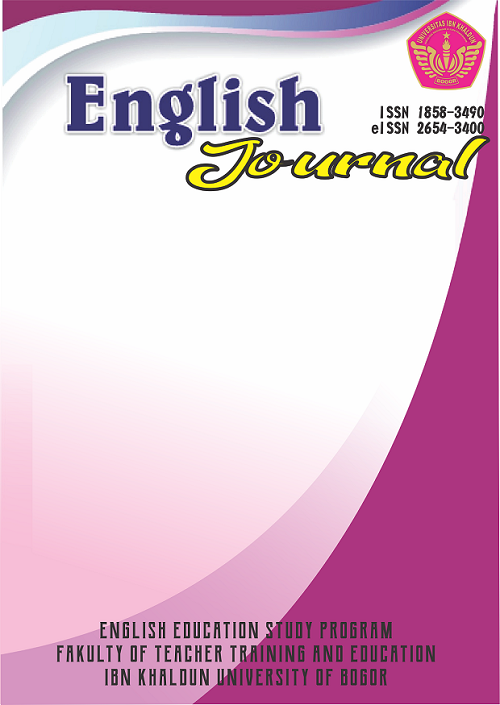THE USE OF SLANG LANGUAGE IN DAILY CONVERSATION AMONG TEENAGERS: DOES GENDER MATTER?
DOI:
https://doi.org/10.32832/english.v16i2.7831Abstract
Nowadays, slang words have now become part of teenagers' everyday language, since they use them in everyday speech. However, due to various of factors, there are disparities in the choice of slang phrases used by teenagers. Since the topic of gender's influence on language usage is not remarkably new, one of the factors that may have a large influence on the choice of slang words used is gender. Relying on this situation, the aims of this study are to investigate the types of slang words used by male and female teenagers, the influences of gender on the choice of slang words and the factors causing the differences. This study referred to the theory of types of slang words by Partridge (2004), gender theory by Diekman and Eagly's (2000), and ethnography of speaking theory by Hymes (1974). This study employed descriptive qualitative method. Observation and interview were employed during the study for the purpose of data collections. The participants of the study were 10 teenagers, 6 females and 4 males which are all college students in Surabaya. The analysis of the collected data revealed that English slang words that are commonly used by teenagers were identified as Society Slang. In addition to that, the investigation on the collected data also shows gender had no influence the choice of slang words. Lastly, the result of the study emphasized that the factors of how each person has their own choice of slang words are speech events which refers to Hymes' SPEAKING term.
References
Amir, K., & Azisah, S. (2017). Gender analysis on slang language in students daily conversation. ETERNAL (English, Teaching, Learning and Research Journal), 3(2), 221-235. DOI: http://dx.doi.org/10.24252/Eternal.V32.2017.A10
Aris, A. (2015). Study of Slang Words in "Ride Along” Movie. Universitas Islam Negeri Maulana Malik Ibrahim Malang, Indonesia. Retrieved from: http://etheses.uin-malang.ac.id/2751/1/11320084.pdf
Han, N. V. (2014). The Relationship Between Language and Gender: A Case Study in Vietnamese. Global Journal of Interdisciplinary Social Sciences, 3(3), 96-99.
Humphries. Panjaitan, T. A. (2017). An Analysis of Slang Word in Zootopia Movie. Universitas Islam Negeri Maulana Malik Ibrahim Malang, Indonesia. Retrieved from: http://etheses.uin-malang.ac.id/14154/1/13320041.pdf
Hymes, D. (1974). Foundations in Sociolinguistics: An Ethnographic Approach. Philadelphia: University of Pennsylvania Press.
Izmaylova, G., Zamaledinova, G., & Zholshayeva, M. (2017). Linguistic and Social Features of Slang. International Journal of Scientific Study. 5(6), 3-7. DOI: https://doi.org/10.17354/ijssSept/2017/016
Jiang, W. (2000). The Relationship Between Culture and Language. ELT Journal, 54(4), 328-334. DOI: https://doi.org/10.1093/elt/54.4.328
Lakof, R. (2009). Language and Women's Place. Language in Society, 2(1), 45-79. Great Britain: Cambridge University Press.
Miles, M. B. & Huberman, M. & Saldana, J. (1994). Qualitative Data Analysis.
Muhingi, W., Mongare, A., Agonga, A., & Muthomi, S. (2016). Gender and Language Use in Learning in Africa: A Critical Review.
Partridge, Eric. (2004). Slang To-Day and Yesterday.
Prihandoko, Lastika Ari. (2012). An Analysis of Slang Words Used by The Characters in "Ramona and Beezuz” Movie. Digital Library UNS. Retrieved from: https://digilib.uns.ac.id
Rosa, Y. (2018). Slang Reflecting Male and Female Rappers' Lexical Styles Seen in Song Lyrics. Konferensi Linguistik Tahunan Atma Jaya 16. Retrieved from: https://kolita.digitalnative.id/assets/uploads/K16/523-527%20Yustina%20Rosa.pdf
Safika. N. D. (2020). Pengaruh Pemakaian Bahasa Gaul terhadap Kemampuan Berbahasa Indonesia Remaja. DOI: https://doi.org/10.31227/osf.io/wrn4u
Safitri, S. (2020). The Use of Slang Words Across Gender by Youtubers. Universitas Islam Negeri Maulana Malik Ibrahim Malang, Indonesia. Retrieved from: http://etheses.uin-malang.ac.id/23321/2/16320052.pdf
Salma, A. (2013). Gender Influence on Slang Used by Teenagers in Their Daily Conversation at School. Passage Journal, 1(2), 63-70.
Sarwono, S. (2016). Anak Jakarta: A Sketch of Indonesian Youth Identity. Wacana: Journal of The Humanities of Indonesia, 15(1), 41-65.
Suhardianto, S., & Ambalegin. A. (2017). The Expansion of Teenagers' Slang Language Application Found in Batam. ELT-Lectura, 4(1), 10-21. DOI: https://doi.org/10.31849/elt-lectura.v4i1.485
Threadgold, T. (1988). Language and Gender. Australian Feminist Studies, 3(6), 41-70. DOI: https://doi.org/10.1080/08164649.1988.9961586
Wardhaugh, R., & Fuller, J. M. (2015). An Introduction to Sociolinguistics. Cambridge: Blackwell.
Zand-Vakili, E., Kashani, A. F., & Tabandeh, F. (2012). The Analysis of Speech Events and Hymes' SPEAKING Factors in the Comedy Television Series: "FRIENDS”. New Media and Mass Communication, 2, 27-43.
Zhou, Y., & Fan, Y. (2013). A Sociolinguistic Study of American Slang. Theory and Practice in Language Studies. 3(12), 2209-2213. DOI: https://doi.org/10.4304/tpls.3.12.2209-2213

















1.png)




